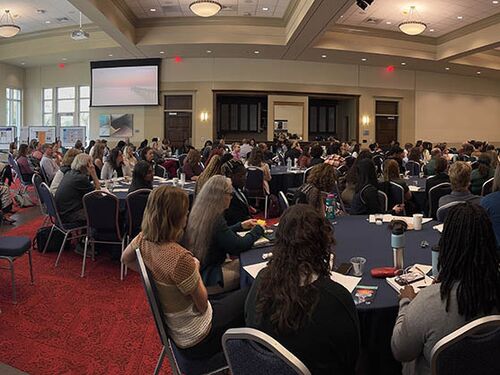Preparing for the Next Influenza Pandemic by Leveraging Lessons from COVID-19 Is Focus of Four New Reports from the National Academy of Medicine
News Release
By Dana Korsen
Last update November 17, 2021
WASHINGTON — The National Academy of Medicine (NAM) today released four reports on applying lessons learned from COVID-19 to prepare for and respond to the next influenza pandemic. The reports provide recommendations on leveraging COVID-19 vaccine technology for influenza vaccine research and development, bolstering the influenza vaccine supply chain, improving global coordination, and effectively using non-vaccine public health measures, such as face masks, physical distancing, and school closures.
Among other findings and recommendations, the reports say the global community should provide continuous investment in vaccine technology; invest in supply chain forecasting; build manufacturing capacity in low- and middle-income countries (LMICs) and be inclusive of their populations in research; and aim to develop 4 billion to 8 billion courses of influenza vaccine to be distributed globally in a timely and equitable manner.
An influenza pandemic comparable to that of 1918, which caused an estimated 50 million deaths worldwide, could potentially have worse consequences than the ongoing COVID-19 pandemic, the reports say. Influenza remains the circulating pathogen most likely to cause a pandemic, and the risk for pandemic influenza may be higher during the COVID-19 era due to changes in global and regional conditions affecting humans, animals, and their contact patterns. Each year, there are 3 million to 5 million cases of influenza globally, and up to 650,000 deaths.
The reports also emphasize the need for a preparedness framework. The global cost of responding to a pandemic in a one-year period is estimated to be $570 billion, while investments in pandemic preparedness would cost just $4.5 billion annually, according to the World Bank International Working Group on Financing Preparedness.
“Seasonal influenza and the next influenza pandemic could emerge at any time. Preparedness has to be an ongoing commitment — it can’t be year to year, or crisis to crisis,” said Victor J. Dzau, president of the National Academy of Medicine. “COVID-19 has enabled the emergence of new capabilities, technologies, collaboration, and policies that could also be deployed before and during the next influenza pandemic. It’s critical to invest in science, strengthen health systems, and ensure trust in order to protect people from the health, social, and economic consequences of seasonal and pandemic influenza.”
The four reports provide recommendations for U.S. federal agencies, the World Health Organization (WHO), and private and philanthropic organizations, among others.
Countering the Pandemic Threat through Global Coordination on Vaccines: The Influenza Imperative
This report outlines the governance and financing structures that can ensure a vaccine is developed ahead of the next pandemic. It contains seven recommendations for incorporating influenza into the broader global pandemic preparedness and response agenda over the next three to five years.
Public-private partnerships should pursue development of new platform technologies that allow researchers to sequence a virus and make a vaccine based on that sequence. In parallel, they should work to develop a universal influenza vaccine that would be able to induce immunity against most or all influenza A virus strains, including future pandemic influenza strains.
The Group of Seven (G-7) and Group of 20 (G-20) should increase investments in surveillance systems for influenza. These systems must work across human, animal, and environmental health, and they should ensure rapid access and sharing of genetic sequence data, given the high mutation rate of influenza viruses. In addition, the World Health Assembly should explicitly clarify that the Pandemic Influenza Preparedness Framework covers genetic sequence data.
Globally Resilient Supply Chains for Seasonal and Pandemic Influenza Vaccines
This report examines the complexities and challenges of supply chains related to influenza vaccines. Drawing on lessons learned from COVID-19 and other public health emergencies, the report identifies steps to scale up manufacturing and facilitate equitable vaccine distribution. It recommends the G-20 convene a Global Pandemic Manufacturing and Supply Chain Task Force to ensure global pandemic influenza manufacturing and supply chain preparedness and response. The task force should extract lessons learned from the COVAX effort during COVID-19.
Some vaccines are more challenging and costly to transport than others, such as those that require storage at ultra-cold temperatures. The U.S. Department of Health and Human Services (HHS) should ensure a systems approach to the design and development of vaccines for feasible distribution and delivery in various global contexts and support relevant innovations.
Country preparedness plans are also important for providing national guidance in vaccine distribution and administration. Many countries lack preparedness plans, and many existing plans are insufficient for mass vaccination. The U.S. and international agencies should facilitate the development of global tools to help countries with better supply planning for vaccines and ancillary supplies, allocation, and rollout decisions, and with obtaining necessary funding for operations.
Vaccine Research and Development to Advance Pandemic and Seasonal Influenza Preparedness and Response: Lessons from COVID-19
This report documents the key drivers of success in the rapid development of COVID-19 vaccines, and how they might be applied to optimize vaccine research and development for seasonal and pandemic influenza. It also identifies research gaps that should be addressed to meet the demand for influenza vaccines.
HHS should support basic and translational research to develop and evaluate a diverse array of influenza vaccines, using different platforms, viral targets, and delivery systems. This will allow for the most appropriate candidate to be brought to authorization, production, and distribution in the event of an influenza pandemic.
Increasing the involvement of LMICs in both clinical trials and vaccine distribution capacities is essential, the report adds. Expanding manufacturing capacity in LMICs will help avoid the delayed rollout of vaccines in these countries. This would not only benefit LMICs but could also benefit the entire world, as it expedites the time to control the pandemic and limits the spread of virus variants.
Regulators and manufacturers should also work together to clarify regulatory standards and streamline messaging to the public. The U.S. Food and Drug Administration and other national regulators, working with the scientific community and pharmaceutical industry, should enhance comprehensive guidance on the development of influenza vaccines through emergency use authorization. Furthermore, to build public confidence in vaccine technology, it is important that public health messaging be thoroughly vetted and coherent across all sources and communication channels.
Public Health Lessons for Non-Vaccine Influenza Interventions: Looking Past COVID-19
Since influenza vaccines may not be immediately available, this report considers the effectiveness of other influenza countermeasures. During the COVID-19 pandemic, face masks and physical distancing contributed to dramatically reducing influenza activity globally. Face masks would be simple and cost-effective during the next influenza pandemic, and public health agencies should mandate their use, when justified by the severity and incidence of influenza.
It is important to consider the similarities and differences between coronaviruses and influenza, the report adds. For example, the policy of closing schools during COVID-19 would have relatively greater payoff for influenza, since children shed influenza viruses for longer and at higher levels than adults. However, mass testing and contact tracing may be less effective, given influenza’s shorter incubation period.
The report also assesses the effectiveness of border closures and lockdowns. It recommends the World Health Assembly amend the International Health Regulations to allow countries to enact border closures during a pandemic of influenza or other respiratory viruses.
The National Academies of Sciences, Engineering, and Medicine carried out these consensus studies as part of the National Academy of Medicine’s Advancing Pandemic and Seasonal Influenza Vaccine Preparedness and Response Initiative. The U.S. Department of Health and Human Services’ Office of Global Affairs (OGA) sponsored the studies, which were undertaken by:
- Committee on Vaccine Research and Development for Advancing Pandemic and Seasonal Influenza Preparedness and Response
- Committee on Addressing Issues of Vaccine Distribution and Supply Chains to Advance Pandemic and Seasonal Influenza Preparedness and Response
- Committee on Global Coordination, Partnerships, and Financing Recommendations for Advancing Pandemic and Seasonal Influenza Vaccine Preparedness and Response
- Committee on Public Health Interventions and Countermeasures for Advancing Pandemic and Seasonal Influenza Preparedness and Response
The National Academy of Medicine, established in 1970 as the Institute of Medicine, is an independent organization of eminent professionals from diverse fields including health and medicine; the natural, social, and behavioral sciences; and beyond. It serves alongside the National Academy of Sciences and the National Academy of Engineering as an adviser to the nation and the international community. Through its domestic and global initiatives, the NAM works to address critical issues in health, medicine, and related policy and inspire positive action across sectors. The NAM collaborates closely with its peer academies and other divisions within the National Academies of Sciences, Engineering, and Medicine.
Contacts:
Dana Korsen, Director of Media Relations
Stephanie Miceli, Media Relations Officer
Office of News and Public Information
202-334-2138; e-mail news@nas.edu


